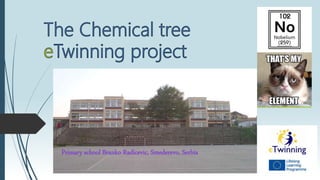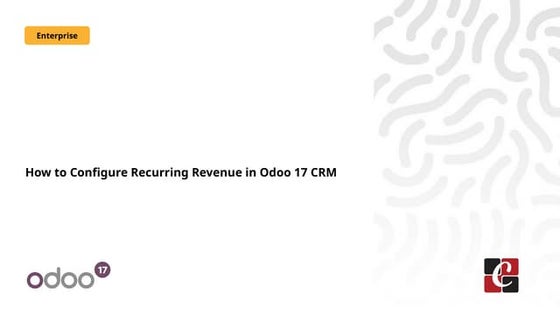The chemical tree
- 1. Primary school Branko Radicevic, Smederevo, Serbia
- 2. All eTwinning project participants from different countries will determine their chemical elements, according a formula and date of birth. The formula that relates the exact date of birth of a person with a number of the chemical element is: where N - is the number of the chemical element in the Periodic Table; x - day of birth (1 to 31); y - birth month (1 to 12); z - the penultimate digit of the year of birth (0 to 9); u - the last digit of the year of birth (0 to 9). N = 1200ùë•+10ùë¶+ùëß+120ù뢂àí1210 400 +1
- 3. Primary school Branko Radicevic Sladjana Rankovic The Chemical tree
- 4. Primary school Branko Radicevic Named after "Thule", an ancient name for Scandinavia. ÔÇ¥ Thulium is the least abundant of the earth elements, and is about as rare as silver, gold, or cadmium. ÔÇ¥ The pure metal has a bright, silvery lustre. It is reasonably stable in air, but the metal must be protected from moisture. The element is silvery- grey, soft, malleable, and ductile, and can be cut with a knife.
- 5. Primary school Branko Radicevic Jana Kostic The Chemical tree
- 6. Primary school Branko Radicevic ÔÇ¥ Ferum in Latin, Eisen in German, Iron in English, means power, strength. Iron has been known since ancient times. It is present in everyday life. It is dark gr–∞y, reactive transition metal which is susceptible to corrosion. Iron is located in the center of the Earth, in volcanic rocks and in the human bodies.
- 7. Primary school Branko Radicevic Kristina Spasic The Chemical tree
- 8. Primary school Branko Radicevic ÔÇ¥ Samarium is a chemical element with symbol Sm and atomic number 62. It is a moderately hard silvery metal that readily oxidizes in air. It is a typical member of the lanthanide series, ÔÇ¥ The major commercial application of samarium is in samarium-cobalt magnets, catalysis of chemical reactions, radioactive dating and an X-ray laser.
- 9. Primary school Branko Radicevic Teodora Katic The Chemical tree
- 10. Primary school Branko Radicevic  Iridis- rainbow, It was named after its colored compounds. It’s a silvery white metal, which when added to other substances makes they sparkle. It can be found in touch screens phones and tablet computers.
- 11. Primary school Branko Radicevic Veljko Maksimovic The Chemical tree
- 12. Primary school Branko Radicevic ÔÇ¥ Kali- the name comes from a word which refers to the name of the port in Malaya from which Tin was exported in large quantity. Tin is too soft, dark silver metal, which melts at a relatively low temperatures, and it easily converts into a powder below 13 degrees. This is a very usefull metal because it serves to protect other metals from corrosion. Tin is a part of Bronze alloy.
- 13. Primary school Branko Radicevic Bogdan Zlatanovic The Chemical tree
- 14. Primary school Branko Radicevic  The other name for Mercury is “Liquid silver”. It was also named after the messenger of the gods -Mercury. It is a grey, liqid metal, easy to evaporate, toxic and deadly. It is accumulated in the bodies of animals, particularly fish that swim in the water wich Mercury pollutes. Mercury attacks the nervous system of those who eat contaminated fish. Alchemists mistakenly thought that they could use Mercury to turn the other base metals into gold. Mercury used to be used in mining, dental fillings and thermometres. Nowadays, it is rarely used because of its toxic effects.
- 15. Primary school Branko Radicevic Staša Banjanin The Chemical tree
- 16. Primary school Branko Radicevic Named after the roman God Mercury, greek God Hermes ÔÇ¥ Mercury was found in Egyptian tombs that date from 1500BC. China and Tibet mercury use was thought to prolong life, heal fractures, and maintain generally good health, although it is now known that exposure to mercury vapour leads to sertious adverse health effects.
- 17. Primary school Branko Radicevic Jana Radosevic The Chemical tree
- 18. Primary school Branko Radicevic Iridis- rainbow, It was named after its colored compounds. It’s a silvery white metal, which when added to other substances makes they sparkle. It can be found in touch screens phones and tablet computers.
- 19. Primary school Branko Radicevic Kristina Aleksic The Chemical tree
- 20. Primary school Branko Radicevic “ Barus” is latin word that means heavy. It is an alkali earth metal, very reactive. Barium colours the flame green, and it is used to make flares and fireworks.
- 21. Primary school Branko Radicevic Milan Stojanovic The Chemical tree
- 22. Primary school Branko Radicevic ÔÇ¥ Solid gallium is a blue-gray metal with orthorhombic crystalline structure; very pure gallium has a stunning silvery color. Gallium is solid at normal room temperatures, but as well as mercury, cesium, and rubidium it becomes liquid when heated slightly. Solid gallium is soft enough to be cut with a knife. It is stable in air and water; but it reacts with and dissolves in acids and alkalis.
- 23. Primary school Branko Radicevic Nevena Kojic The Chemical tree
- 24. Primary school Branko Radicevic Mercury metal has many uses. Because of its high density it is used in barometers and manometers. It is extensively used in thermometers, thanks to its high rate of thermal expansion that is fairly constant over a wide temperature range. Its Its ease in amalgamating with gold is used in the recovery of gold from its ores. liquid Industry uses mercury metal as a electrode in the manufacture of chlorine and sodium hydroxide by electrolysis of brine. Mercury is still used in some electrical gear, such as switches and rectifiers, which need to be reliable, and for industrial catalysis. Much less mercury is now used in consumer batteries and fluorescent lighting, but it has not been entirely eliminated.
- 25. Primary school Branko Radicevic Marija Vuckovic The Chemical tree
- 26. Primary school Branko Radicevic  “Calx” – means lime, It is very important and widespread alkaline earth metal, gray, very soft, and reactive to water and oxygen, biogenic element. Its compounds can be very strong.
- 27. Primary school Branko Radicevic Dejana Popovic The Chemical tree
- 28. Primary school Branko Radicevic Named after asteroid Palas, a greeks Greek goddess of wisdom, Athena Paladis ÔÇ¥ Palladium is found as the free metal associated with platinum and other platinum group metals ÔÇ¥ Palladium is a lustrous silver-white metal. It has a face-centered cubic crystalline structure, at ordinary temperatures it is strongly resistant to corrosion in air and to the action of acids. It is attacked by hot acids, and it dissolves in aqua regia. It forms many compounds and several complex salts. Palladium has a great ability to absorb hydrogen
- 29. Primary school Branko Radicevic Milena Ristic The Chemical tree
- 30. Primary school Branko Radicevic Beryllium is a toxic bivalent element, steel gray, strong, light-weight, primarily used as hardening agent in alloys. Beryllium has one of the highest melting points of the light metals. It has excellent thermal conductivity, is nonmagnetic. Beryllium is used as an alloying agent in the production of beryllium-copper. Beryllium is not an element that is crucial for humans; in fact it is one of the most toxic chemicals we know. It is a metal that can be very harmful when humans breathe it in, because it can damage the lungs and cause pneumonia.
- 31. Primary school Branko Radicevic Vanja Dinic The Chemical tree
- 32. Primary school Branko Radicevic ÔÇ¥ Tin is a chemical element with symbol Sn (for Latin: stannum) and atomic number 50. It is a post-transition metal in group 14 of the periodic table. It is obtained chiefly from the mineral cassiterite, Tin shows a chemical similarity to both of its neighbors in group 14, germanium and lead ÔÇ¥ Tin is the 49th most abundant element and has, with 10 stable isotopes, the largest number of stable isotopes in the periodic table, thanks to its magic number of protons
- 33. Primary school Branko Radicevic Nevena Stevanovic The Chemical tree
- 34. Primary school Branko Radicevic ÔÇ¥ Barium is a soft silvery metallic alkaline earth metal. Because of its high chemical reactivity, barium is never found in nature as a free element. The silvery-white color of barium metal rapidly vanishes upon oxidation in air yielding a dark gray oxide layer. Barium has a medium specific weight and good electrical conductivity. ÔÇ¥ Barium is chemically similar to magnesium, calcium, and strontium, but even more reactive.

















































































